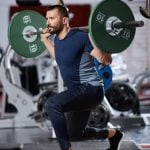Are bodyweight workouts enough to be fit? This has been a question that many fitness enthusiasts have pondered over the years. In recent times, bodyweight exercises have gained popularity as a convenient and accessible way to build strength and endurance. As we delve into the debate on the effectiveness of bodyweight workouts in achieving fitness goals, it is essential to understand the science behind these exercises and the benefits they offer.
Bodyweight workouts involve using one’s body weight as resistance for strength training activities such as push-ups, squats, and planks. The key premise behind these exercises is that they can effectively challenge and engage different muscle groups without the need for additional equipment. Research has shown that bodyweight exercises can improve muscle tone, increase cardiovascular health, and enhance overall physical fitness levels.
One of the significant advantages of bodyweight workouts is their versatility and scalability. Whether you are a beginner or an experienced athlete, bodyweight exercises can be modified to suit your fitness level. Additionally, these workouts can be performed virtually anywhere, making them ideal for individuals with busy schedules or limited access to gym facilities.
However, the question remains: Are bodyweight workouts alone sufficient for achieving overall fitness goals? In the following sections, we will explore this topic further and provide insights on how to maximize the effectiveness of bodyweight exercises in your fitness routine.
The Science Behind Bodyweight Workouts
Resistance Training With Bodyweight Exercises
Bodyweight workouts involve using your body weight as resistance to build strength and endurance. This type of training activates multiple muscle groups simultaneously, leading to a more functional and holistic approach to fitness. By performing exercises like push-ups, squats, planks, and lunges, individuals can target major muscle groups such as the chest, shoulders, back, legs, and core. Over time, consistent bodyweight training can increase muscle mass and improve overall muscular strength.
Cardiovascular Endurance Benefits
In addition to building strength, bodyweight workouts also play a significant role in enhancing cardiovascular endurance. Compound movements like burpees, mountain climbers, and high knees elevate the heart rate while engaging different muscle groups. This combination of strength and cardio elements within bodyweight exercises helps improve overall fitness levels. Regular participation in bodyweight workouts can lead to increased stamina and better cardiovascular health.
The Role of Bodyweight Workouts in Physical Fitness
While traditional strength training methods often involve equipment like dumbbells or resistance machines, bodyweight workouts offer a convenient and accessible alternative. They can be performed anywhere without the need for specialized equipment or a gym membership. The versatility of bodyweight exercises allows individuals to customize their workout routines based on their fitness goals and preferences. When done correctly and consistently, bodyweight workouts have proven to be effective in achieving overall fitness goals by improving strength, endurance, flexibility, and mobility.
Benefits of Bodyweight Workouts
Bodyweight workouts have gained popularity in the fitness world for their numerous benefits and advantages. One of the key advantages of bodyweight exercises is that they require minimal to no equipment, making them accessible to everyone regardless of their location or financial resources. This convenience allows individuals to incorporate bodyweight workouts into their daily routines without the need for a gym membership or specialized equipment, making it a cost-effective way to stay fit.
Additionally, bodyweight exercises are highly versatile and can be modified to suit different fitness levels. Whether you are a beginner looking to build strength or an experienced athlete wanting to challenge yourself, bodyweight workouts can be adapted to meet your specific needs. From basic movements like squats and push-ups to more advanced exercises like handstands and pistol squats, there is a wide range of options available for individuals of all skill levels.
Furthermore, bodyweight workouts are functional in nature, as they often mimic natural movements that we perform in our daily lives. By engaging multiple muscle groups simultaneously through compound exercises, bodyweight workouts help improve coordination, balance, and flexibility. The dynamic nature of these exercises also enhances core stability and overall athleticism, leading to better performance in sports and other physical activities. Overall, the benefits of bodyweight workouts extend beyond just physical appearance, promoting total-body wellness and functional fitness.
Are Bodyweight Workouts Enough?
The debate on whether bodyweight workouts are enough to be fit is a common topic among fitness enthusiasts. While bodyweight exercises can certainly help individuals build strength and endurance, there are factors to consider when determining if they alone are sufficient for achieving overall fitness. Bodyweight workouts involve using your own body weight as resistance, which can be effective in improving muscle tone and cardiovascular health.
One of the key advantages of bodyweight workouts is that they can be done anywhere, anytime, without the need for expensive equipment or gym memberships. This accessibility makes them ideal for individuals who prefer to work out at home or while traveling. Additionally, bodyweight exercises like push-ups, squats, and planks engage multiple muscle groups at once, providing a full-body workout that can improve functional fitness.
However, it is important to note that while bodyweight workouts can be highly effective in building strength and endurance, they may not provide enough resistance for individuals looking to bulk up or significantly increase muscle mass. In such cases, incorporating additional resistance training with weights or other equipment may be necessary. It is essential to tailor your workout routine to your specific fitness goals and continually challenge your muscles in order to see progress over time.
| Advantages of Bodyweight Workouts | Considerations for Overall Fitness |
|---|---|
| Accessibility – can be done anywhere | Additional resistance training may be needed for specific goals |
| Engages multiple muscle groups | Tailoring workout routine to individual goals is essential |
Tips for Maximizing Bodyweight Workouts
Bodyweight workouts are a convenient and effective way to improve strength, endurance, and overall fitness. By utilizing your own body weight as resistance, you can target multiple muscle groups and boost your cardiovascular health. However, to ensure that you are maximizing the benefits of bodyweight exercises, it is essential to incorporate certain strategies into your workout routine.
Here are some tips for optimizing the effectiveness of your bodyweight workouts:
- Focus on proper form: Maintaining good form during bodyweight exercises is crucial to prevent injuries and target the intended muscles. Take the time to learn the correct technique for each exercise and concentrate on executing it with precision.
- Progress gradually: To continue seeing improvements in your fitness level, it is important to challenge yourself by increasing the difficulty of your workouts over time. Gradually progress by adding more repetitions, reducing rest time between sets, or incorporating more challenging variations of exercises.
- Include compound movements: Compound exercises engage multiple muscle groups simultaneously, making them efficient for building strength and burning calories. Incorporate compound movements like push-ups, squats, and lunges into your routine for a full-body workout.
By following these tips and consistently pushing yourself during bodyweight workouts, you can enhance your physical performance and achieve greater results in terms of strength, endurance, and overall fitness. Remember that consistency is key when it comes to seeing progress in your fitness journey through bodyweight exercises.
Incorporating Variety
Bodyweight exercises are a great way to build strength, endurance, and flexibility without the need for any equipment. However, in order to maximize the benefits of bodyweight workouts and target different muscle groups effectively, it is important to incorporate a variety of exercises into your routine. By diversifying your bodyweight workouts, you can avoid overworking certain muscles and reduce the risk of injury while also keeping your workouts engaging and challenging.
Here are some examples of different bodyweight exercises that target specific muscle groups:
- Squats: Targeting the quadriceps, hamstrings, glutes, and core muscles
- Push-ups: Working the chest, shoulders, triceps, and core
- Planks: Engaging the core muscles as well as the shoulders and lower back
- Lunges: Strengthening the legs – specifically the quadriceps, hamstrings, and glutes
- Pull-ups: Focusing on the back muscles – including the latissimus dorsi and biceps
By alternating between these exercises and incorporating variations such as one-legged squats or wide-grip push-ups, you can ensure that you are targeting all major muscle groups in your body. This not only helps in building balanced strength but also prevents muscle imbalances that may lead to injuries in the long run.
In addition to targeting different muscle groups with a variety of exercises, it is also important to vary the intensity and volume of your bodyweight workouts. By increasing repetitions or trying more challenging variations of exercises as you progress in fitness level, you can continue to see improvements in strength and endurance.
Remember that consistency is key when it comes to seeing results from bodyweight workouts – so make sure to stay committed to your routine while keeping it varied and engaging.
Progression and Overcoming Plateaus
When it comes to bodyweight workouts, one of the common concerns that individuals have is whether they provide enough progression to continuously challenge their fitness levels. Progression in bodyweight exercises is essential for building strength, muscle endurance, and overall fitness. To ensure that bodyweight workouts are effective in achieving fitness goals, it is crucial to understand how to progress in these exercises and avoid hitting plateaus.
One way to progress in bodyweight workouts is by manipulating variables such as intensity, volume, and frequency. By increasing the number of repetitions, sets, or difficulty of the exercises over time, you can continue to challenge your muscles and prevent them from adapting to the same routine. For example, if you have mastered a standard push-up, you can progress to more challenging variations like decline push-ups or one-arm push-ups to keep your muscles guessing and growing.
It is also important to incorporate progressive overload into your bodyweight training routine. This means gradually increasing the resistance or difficulty of the exercises as your strength improves. You can achieve this by using resistance bands, adding weights (e.g. a weighted vest), or changing leverage positions in exercises like planks or squats. By implementing progressive overload smartly into your bodyweight workouts, you can avoid hitting fitness plateaus and continue making gains in strength and muscle development.
Bodyweight Workouts vs Traditional Strength Training
Bodyweight workouts have gained popularity in recent years as a convenient and effective way to stay fit without the need for expensive gym equipment. Many individuals wonder if bodyweight workouts alone are enough to be fit. The truth is that bodyweight exercises can indeed help you achieve your fitness goals, especially when done consistently and with proper form. However, whether they are sufficient for overall fitness depends on various factors such as your fitness level, goals, and preferences.
One of the key advantages of bodyweight workouts is that they can be done anywhere, anytime, making them accessible to a wide range of individuals. Additionally, bodyweight exercises like push-ups, squats, and planks can help build strength, improve muscular endurance, and boost cardiovascular fitness.
These exercises engage multiple muscle groups simultaneously, providing a full-body workout that targets both primary and stabilizing muscles. Moreover, bodyweight workouts often involve functional movements that mimic everyday activities, helping improve balance, coordination, and flexibility.
While bodyweight workouts offer numerous benefits, it is essential to consider whether they provide enough stimulus for continued progress in strength and muscle gains over time. For some individuals, bodyweight exercises may reach a plateau where additional resistance is needed to continue seeing improvements in muscle mass and strength.
This is where traditional strength training methods like weightlifting come into play. Weightlifting allows for progressive overload by adjusting the weight lifted, which can lead to greater muscle hypertrophy compared to bodyweight exercises alone.
| Advantages of Bodyweight Workouts | Can Be Done Anywhere Without Equipment |
|---|---|
| Engage multiple muscle groups simultaneously | Convenient for busy schedules |
| Improve balance, coordination & flexibility | Suitable for beginners or those new to exercise |
Real-Life Success Stories
There are countless real-life success stories of individuals who have achieved their fitness goals through bodyweight workouts. These inspiring anecdotes serve as proof of the effectiveness of bodyweight exercises in building strength, endurance, and overall fitness.
One such example is Sarah, a busy mother of two who managed to transform her physique and improve her health solely through a consistent bodyweight workout routine at home. Despite not having access to a gym or fancy equipment, Sarah was able to sculpt her body and increase her fitness level by performing bodyweight exercises like push-ups, squats, planks, and burpees.
Another success story is that of John, a former athlete who wanted to regain his athletic form after years of being sedentary. Instead of diving back into intense weightlifting routines, John decided to start with bodyweight workouts to gradually rebuild his strength and conditioning.
By incorporating a combination of calisthenics movements and HIIT (High-Intensity Interval Training) sessions, John was able to see significant improvements in his muscle tone and cardiovascular endurance. Not only did he achieve his fitness goals, but he also surpassed them by reaching new levels of physical performance thanks to his dedication to bodyweight training.
These success stories highlight the fact that bodyweight workouts can indeed be enough to achieve remarkable fitness results. By consistently challenging the muscles with different bodyweight exercises and progressively overloading them over time, individuals can see growth in strength, endurance, flexibility, and overall fitness levels.
It’s not about the equipment or the environment; it’s about the commitment and effort put into each workout session that ultimately determines how far one can go in their fitness journey using just their own body weight as resistance.
Conclusion
In conclusion, the debate on whether bodyweight workouts are sufficient to achieve fitness goals is a nuanced one. While the science behind bodyweight exercises demonstrates their ability to build strength and endurance, the question still remains: Are bodyweight workouts enough to be fit?
The benefits of bodyweight workouts, including their versatility, accessibility, and cost-effectiveness, make them a valuable component of any fitness routine. However, it is essential to acknowledge that incorporating a variety of bodyweight exercises targeting different muscle groups is crucial for overall fitness development.
To maximize the effectiveness of bodyweight workouts, individuals should focus on progression and strategies to overcome plateaus in their fitness journey. By continually challenging oneself through increasing repetitions, incorporating new variations, or adding resistance, individuals can ensure continued progress in their strength and endurance levels.
Additionally, comparing bodyweight workouts to traditional strength training methods reveals that both have their own advantages and disadvantages. While traditional strength training may offer more opportunities for heavy resistance and muscle hypertrophy, bodyweight exercises provide functional fitness benefits that can improve everyday movements.
Real-life success stories serve as testament to the effectiveness of bodyweight workouts in achieving fitness success. By consistency and dedication to their workout routines, individuals have transformed their bodies and improved their overall health using bodyweight exercises alone.
Ultimately, while bodyweight workouts can indeed be enough to achieve fitness goals for many individuals, it is important to customize one’s routine based on personal preferences, goals and limitations. With proper planning and execution, bodyweight workouts can undoubtedly be a powerful tool in attaining a fit and healthy lifestyle.
Frequently Asked Questions
Can You Get Fit With Just Bodyweight Exercises?
Yes, you can definitely get fit with just bodyweight exercises. Bodyweight exercises like push-ups, squats, planks, and burpees can help build strength, endurance, and improve overall fitness levels without the need for equipment.
Is Bodyweight Fitness Enough?
Bodyweight fitness can be enough for many individuals, especially beginners or those looking to maintain their current level of fitness. It offers a convenient and cost-effective way to workout without needing a gym membership or specialized equipment. However, those seeking specific fitness goals may need to incorporate additional components into their routine.
Are Bodyweight Exercises Enough to Get Ripped?
While bodyweight exercises can help build muscle and increase strength, getting ripped often requires a more focused approach that includes not only exercise but also attention to diet and other lifestyle factors.
To achieve a ripped physique, a combination of resistance training, cardiovascular exercise, proper nutrition, and adequate rest is typically needed in addition to bodyweight exercises to reach that level of muscular definition.

Passionate about providing useful information to anyone with an interest in the field of Personal Training, I strive to pass on to our readers quality information and to answer any questions about Personal Trainers, the work they do and how to become one.





